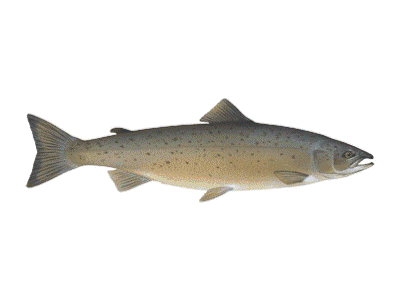
The U.S. Fish and Wildlife Service and NOAA Fisheries have released a new final recovery plan for endangered Atlantic salmon. The only remaining populations of this species in the USA occur in Maine.
The recovery plan guides the species’ recovery, and outlines specific approaches to reduce threats to the species, identifies specific timetables for action, and estimates costs to achieve recovery goals.
Atlantic salmon grow to maturity in marine waters and return to freshwater rivers and streams to spawn.
The Gulf of Maine population has been declining since the 1800s, when an estimated 100,000 adult salmon returned to the Penobscot River alone.
Since 1967, there have been very few years when more than 5,000 salmon have returned to Maine. In 2017, just over 1,000 salmon returned to spawn in Maine rivers.
Currently, natural spawning of returning fish is supplemented by a conservation hatchery program designed to preserve the genetic diversity of the Gulf of Maine population and increase abundance.
This recovery plan addresses the Gulf of Maine distinct population segment (DPS) of Atlantic salmon, which are the only remaining wild Atlantic salmon in the United States. The recovery plan replaces a 2005 plan that addressed the DPS listed as endangered in 2000.
In 2009, the DPS listing was expanded to include most of the Androscoggin, Kennebec, and Penobscot basins. The 2019 recovery plan includes all remaining wild populations of Atlantic salmon that occur from the Androscoggin River in Southwestern Maine to the Dennys River in Eastern Maine.
The recovery plan provides a vision for Atlantic salmon recovery that includes long-term objectives and criteria, research and management actions, and time and cost estimates to recover and conserve the species in its native habitats.
The plan incorporates new scientific information and lays out a set of actions to:
Enhance connectivity between ocean and freshwater habitats;
Maintain the genetic diversity of populations over time;
Increase the number of spawning adults through the hatchery program;
Increase the number of spawning adults through freshwater production;
Increase survival in marine and estuary habitats by increasing our understanding of these environments;
Use adaptive management to modify future activities based on increased current knowledge;
Build awareness and engage with partners and the public; and
Coordinate partner efforts to provide the greatest benefit to salmon.The agencies, which co-manage the species, released a draft recovery plan for public comment in 2016. The final plan and supporting documents share those comments as well as how they were addressed by the agencies.
The plan was reviewed by the State of Maine, tribal representatives, other governmental agencies and independent scientific reviewers.
2019 is the International Year of the Salmon, an initiative that aims to bring people together to share and develop knowledge more effectively, raise awareness, and take action to build resilience for salmon and people around the northern hemisphere. While 2019 is the focal year of the IYS, research and outreach under this initiative will continue through 2022.
source: NOAA Fisheries Greater Atlantic Regional Fisheries Office
Related Information
Atlantic Salmon (species profile)